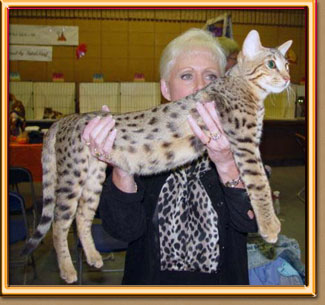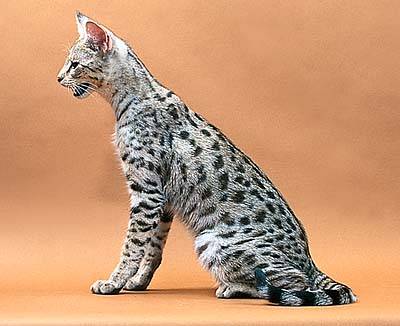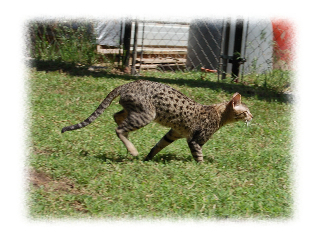New Mystery Cat Photos Questioned
Posted by: Loren Coleman on August 4th, 2008
Is there another unknown felid being seen on the University of Maryland campus? Should we question the quick identification being given to this cat?

C & C Savannahs shows off one of its prize examples of the breed. Carol Streit/Callie Ingram Photo.
According to the Sunday Washington Post article entitled, “Authorities Take Photos Of Elusive Large Cat” by Martin Weil and Clarence Williams, the phantom feline has been identified.
But I wonder if the identification is wrong?
Authorities at the College Park campus were able to obtain photographs of an unidentified feline that, while not quite a cougar, they said, seemed far larger than a standard house cat, on Friday, August 1, 2008.
The University of Maryland’s Department of Public Safety said it got surveillance camera pictures of a “large feline” at the edge of a wooded area where what was believed to be a cougar had been reported. In addition, the department said, a university police officer got to see the big cat close up.
The verdict, occurring to the Washington Post, after consulting with the state Department of Natural Resources, was no cougar.
In its size and markings, the safety department said, the mystery cat appeared to be consistent with the savannah cat, which it described as a hybrid of a domestic short haired cat and a larger African feline, the serval.
According to a statement from the safety department, savannahs can weigh as much as 35 pounds, and can be much bigger than house cats. savannahs, the department said, have been called the great danes of the cat world.
As of last night, the savannah cat, if that is truly what it is, remained at large. It was not immediately known how it came to be in the area where reports of cougar sightings Thursday created a summertime stir on campus.
But at Cryptomundo, without the benefit of seeing the photographs, I must question this verdict, based on the marketing hype that these savannahs are generally that big.

The classic pose of the savannah cat.


One of A1 Savannahs playing in the yard. Could you mistake this cat for a cougar?
The serval.
The weight of the mystery cat pictured is reportedly estimated to be 35-40 pounds, and yet they are saying it is a savannah cat. The first generation savannahs (in 1986) were 10 to 25 pounds, but today they are generally 8 to 17 pounds.
Servals, however, weigh from 20 to 44 pounds.
Male cougars have an average weight of 115 to 160 pounds (53 to 72 kilograms). In rare cases, some cougars may reach over 260 lbs (118 kg). Female cougars average weight is between 34 and 48 kg (75 and 105 lbs). Cougar size is smallest closer to the equator, and larger towards the poles, so the Florida panther, for example, is slimmer than the bulky Montana mountain lion.
Someone may have a different species of cat on their hands, that’s for sure. I doubt it is a domesticated breed, such as the savannah cat. That’s the easy answer but it may also be the wrong one.
Plus, this does not answer the sightings of a cougar on campus.
What’s going on in College Park?
Meanwhile, a half-a-world away, as they say, Australia announced on Sunday that they have banned savannah cats from their country.
The most anti-savannah cat articles there would share these kinds of remarks about the weight of the animal: “This hybrid carnivore is twice the size of a domestic cat, with occasional giants (18 kg = 39 lbs) as overwhelming evidence of hybrid vigour.”
Environment Minister Peter Garrett has banned savannah cats from Australia, saying they pose an extreme risk to native animals and the environment. Garrett said he would change the legal definition of “domestic cat” to rule out cats with the genes of the African wildcat, the serval.
That means no savannah cats in Australia, point.
Of course, as when the exotic animals act was put into place in the UK in the 1970s, what does this mean will happen to all those Australian pets that happened to be savannah cats? Will there be a massive release of them now? Will spotted feral cats larger than domestic cats be sighted all over the Gold Coast of Australia?
About Loren Coleman
Loren Coleman is one of the world’s leading cryptozoologists, some say “the” leading living cryptozoologist. Certainly, he is acknowledged as the current living American researcher and writer who has most popularized cryptozoology in the late 20th and early 21st centuries.
Starting his fieldwork and investigations in 1960, after traveling and trekking extensively in pursuit of cryptozoological mysteries, Coleman began writing to share his experiences in 1969. An honorary member of Ivan T. Sanderson’s Society for the Investigation of the Unexplained in the 1970s, Coleman has been bestowed with similar honorary memberships of the North Idaho College Cryptozoology Club in 1983, and in subsequent years, that of the British Columbia Scientific Cryptozoology Club, CryptoSafari International, and other international organizations. He was also a Life Member and Benefactor of the International Society of Cryptozoology (now-defunct).
Loren Coleman’s daily blog, as a member of the Cryptomundo Team, served as an ongoing avenue of communication for the ever-growing body of cryptozoo news from 2005 through 2013. He returned as an infrequent contributor beginning Halloween week of 2015.
Coleman is the founder in 2003, and current director of the International Cryptozoology Museum in Portland, Maine.










The making of a cryptid…
You know, I have been thinking–a 35-40 pound cougar looking cat would be a caracal, also known as an African or Persian lynx. They look basically like a cougar, except they have large, pointed, tufted ears. But their coloration is very much similar, and their body shapes–particularly their face shapes are similar enough to fool people at a quick glance.
I know that there are those in the US who keep them as pets (I am dumb enough to have thought about it myself, but it was only a thought, never acted upon), so we may have one who got loose from his or her home.
/
But it would be nice to actually look at the photos, wouldn’t it?
I’m glad we’ve banned them in Oz for obvious reasons. Now all we’ve got to do is ban rock stars from becoming politicians (as in Environment Minister Peter Garrett ). 😉
Nice article and education on these beautiful beasts, Loren…
davidk, the problem with banning any exotic species is much like Loren has stated, many who already own them will simply release them into the wild, so instead of seeing less, you will actually start seeing more…. if savannah cats are a popular pet in Australia, there may even be enough of them released to produce breeding populations….. one reason the US has been very carefull to avoid an outright ban on exotic pets is for just such a reason.
Here’s an article which DOES include a video of this alleged “Savannah” cat.
Although the video, like most videos of “mysterious” creatures, is of poor quality, it does show a distinctly striped, not spotted, tabby cat prowling through some undergrowth, which stops and apparently relieves itself, then moves on.
To me, it does not look like a Savannah, which I’ve seen at TICA cat shows, or any other “exotic” cat breed, but an ordinary large tabby Domestic Shorthair.
The rounded head, smallish pointy ears and legs that are of normal house cat proportions just don’t say, “Savannah Cat” to me. How this distinctly striped kitty could have been mistaken for a “cougar” is beyond me!
It could be a Bengal, which was originally created by crossing domestic cats with Asian Leopard Cats (Felis bengalensis), and which have been bred Bengal-to-Bengal now for many, many generations, but the video is just not clear enough. I’d still wager it’s an ordinary, if somewhat large, domestic cat, and that weights of “50 pounds” are greatly exaggerated.
People DO tend to overestimate the size and weight of animals, even their own pets, often by a large margin, so it would not surprise me that someone would look at a 20-pound tabby and greatly overestimate its size. I still don’t see how it could be mistaken for a cougar, though!
I’m not sure there are any savannah cats in Australia yet Loren. Perhaps in zoos. I was one of the 500+ who wrote to the minister and still think this is the right decision – despite the fact we have plenty of other environmental problems, and despite other cat breeds being permitted into the country at present. Just because we allow one breed doesn’t mean it should be open slather for all breeds, and making a decision to ban one is a step in the right direction.
Think about no-smoking areas – although I don’t know if it’s the same worldwide – I think Australia might be a leader in this regard. The idea of non-smoking areas used to be preposterous, but they were introduced and gradually more and more areas have become non-smoking. My local paper reports numerous councils in Sydney now banning smoking in all public open spaces (i.e. parks) – can you imagine that?
Now – there is a couple here in Australia who had begun setting up a business to import and sell these cats. They’re threatening to sue the government (that earlier backed their enterprising plan) for the change of mind. I see their point. They bought land, built fences, took deposits from buyers and made commitments to their supplier. They want to claim A$2 million in damages. My question is – if any savannah cat did get into the wild and kill native fauna, would they be volunteering A$2 million to control the problem?
When a dog gets off its owner’s property and attacks a child, the owner is fined. Most native fauna is protected. When a cat gets off a property and kills native fauna, why aren’t the owner’s fined? Because you can’t police that. But the reality is that the choice to import breeds like the savannah cat result in loss of native fauna upon which you can’t place a monetary value.
I guess it would be a relief to many if there was no cougar in the area – but I just have this feeling people may have been seeing two different animals here
This cat IS marked just like my classic tabbies, with the big black stripe on the top of the head. However, when the video zooms in from the lamp post to the cat, I get an impression that the cat is much bigger than a large house cat. It definitely is not an adult cougar. Are baby cougars this heavily striped? A possibility would be a Savannah cat which did not breed true with the requisite markings for showing, and somehow ended up in the wild. It certainly behaves in this clip with confidence of a cat that is accustomed to being outdoors, not a recently escaped and frightened pet. I have seen no remarks about attempts to trap the animal with a humane trap, which might work easily if it is a hungry pet.
Considering mainstream theory, it sounds like the Austrailians have banned all domestic cats, since they have ‘genes from the African wild cat’. Sigh.
Would a Savannah eat rabbits?
@DontCryBigfoot
Not quite. There are no specimens in the country presently. If there were they’d be illegal and the fines are huge (along with the jail time). Stopping it now really is a good thing. We have a history of exotics going beserk in this country. Dingos, Cane Toads, Goats, Pigs, Cats, Rabbits and more. In some instances it’s been like the little old lady who swallowed a fly, so she swallowed a spider, then swallowed a bird… We bring in Cane Toads to eat Cane Beetles, they ignore the beetles and eat everything else, kill most predators with their poison. Foxes to catch rabbits – that failed. Heck, we’ve even got Cichlids and Guppies and Goldfish in the river systems and in many cases wiping out native fish entirely (not to mention the introduction of European Carp, Trout, RedFin et al). So far, since the import rules were truly enforced, we’ve been very successful in keeping out others. People do bring them in, but they do get caught. Of the forty mammal species known to have vanished in the world in the last 200 years, almost half have been Australian.
Oh for God’s sake. Get a grip on reality. It’s an Egyptian Mau. The oldest breed of cat in the world. I have one. No big deal. Some one is trying to make it all spooky and mysterious just to make a buck. Aliens….Bigfoot…..Spotted big cat. What next? Square watermelons? Oh wait. Yeah, we have them , too
We (Eastern Puma Research Network) were contacted by Captain John Brandt of Univ. of Maryland Campus Police to help in identifying a large mystery cat on 8/1/08 at about 1:30PM.
We responded from Grant Co, WV, & arrived about 5:17PM. Then was shown a security camera tape from approx 300 ft away. Cat in picture was NOT a cougar. It was much smaller with rounded ears, small face/head, spots across body & stripes on chest & tail. Tracks found in dirt near Cole Fieldhouse were NOT of a cougar, measuring 2.29″ wide with 4 toes.
We were thanked for our assistance & asked NOT to release any data on event, as Campus PIO would handle it.
It was ok with us. We asked for a copy of that tape, but as of Aug.21st, 2008, it has NOT been received.
We were told Maryland DNR was NOT handling the incident, since they had determined the feline was NOT native to state. In other words, they didn’t want involvement if it was a cougar, since they are extremely negative to subject.
Yet when the news media appeared on the UMD Campus on Monday, 8/4/08, 5 Md DNR trucks & officials were on the scene just to show their presence on TV…what we call “funny-come-lately”.
In contact with news media friends on Baltimore’s WJZ-TV this 8/22/08 morning, NO further sightings of median to large felines have been reported to the news media. AMEN!!!
However since early 1970s, there have been repeated cougar sightings on the Howard County side of Tridelphia Reservoir, about 20 miles NW of the College Park Univ. of Maryland Campus.
Tracks of a cougar was CONFIRMED near Damacus in NW Montgomery Co in 1974.